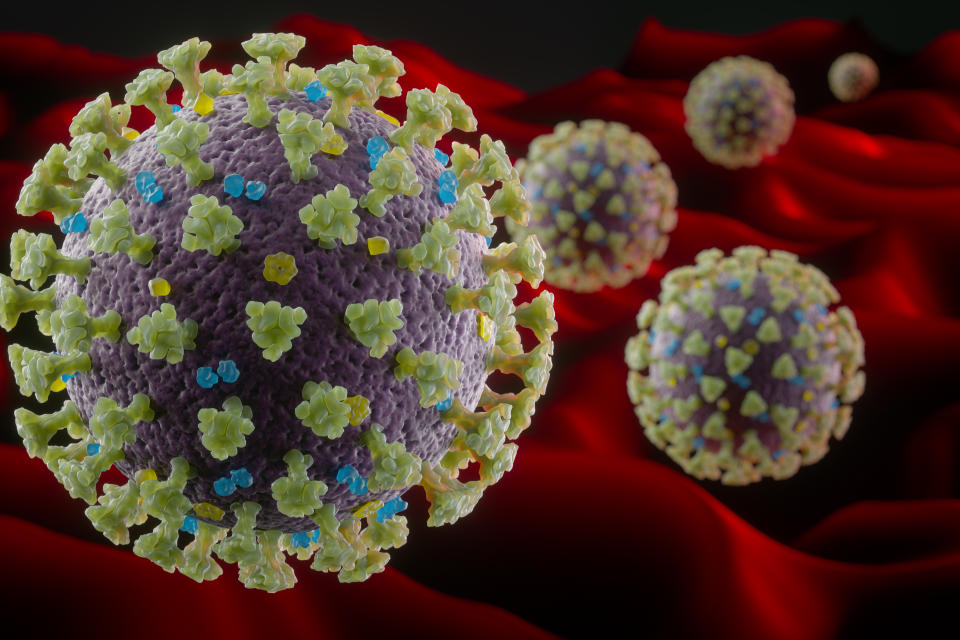What makes COVID-19 so dangerous for some?

More than a million people worldwide are known to have died after testing positive for the coronavirus.
While early research suggests the infection is mild in four out of five cases, a subset of patients endure life-threatening complications.
Everything from pneumonia and punctured lungs to cardiac arrests and sepsis has been reported among critically-ill COVID patients.
Read more: Smokers quit but 'high-risk' drinking increased during lockdown
No vaccine and limited treatment options mean wearing face coverings, maintaining social distancing and regular hand washing remains our best defence.
With the coronavirus unheard of this time last year, many are wondering what makes the infection so dangerous for some.

Asymptomatic cases do not know to isolate
Anyone in the UK who comes down with the coronavirus’ tell-tale fever, cough, or loss of taste or smell must self-isolate immediately.
While it may seem a simple instruction, issues arise when people with the infection develop no symptoms.
The rate of asymptomatic cases has been debated throughout the outbreak.
On 3 March, the World Health Organization’s director-general Dr Tedros Adhanom Ghebreyesus said: “Evidence from China is only 1% of reported cases do not have symptoms and most of those cases develop symptoms within two days”.
Scientists from the University of Hong Kong later claimed 12.1% of patients do not develop a fever.
According to Professor Paul Lehner from the University of Cambridge “up to 75% are asymptomatic”.
It has also been suggested most people who appear to be asymptomatic actually have “really mild disease”.
Read more: Coronavirus vaccine trials will not tell us if a jab saves lives
Among those who notice their symptoms, some research implies patients are at their most infectious before they feel ill.
“Viral infectivity peaks 24 hours before you become unwell,” said Professor Lehner.
Through no fault of their own, these patients do not know to self-isolate.
“You’re maximally transmitting the virus while feeling well,” said Professor Lehner. “You can be at the races, at the pub, singing in a choir.”
The circulating coronavirus is one of seven strains of a virus class that are known to infect humans.
It is said to be most genetically similar to severe acute respiratory syndrome (Sars), which killed 774 people during its 2002/3 outbreak, but has had no reported cases since 2004.
The circulating coronavirus is “different from Sars, where you became maximally infected five days down the line”, according to Lehner.
The issue of asymptomatic transmission has been debated. Other experts have argued those who do not cough or sneeze – which are both symptoms and the main routes of transmission – would be expected to spread the coronavirus to fewer people.
Watch: Can you catch coronavirus twice?
Coronavirus may linger in tissues
A coronavirus patient is generally thought to have overcome the infection if a throat and nose swab comes back negative.
It has been suggested, however, pockets of the virus may persist in other parts of the body.
While the individual is not thought to be infectious, the virus may linger in places like the gut, potentially causing diarrhoea.
This is one explanation for the phenomenon long COVID, when a former coronavirus patient endures complications after testing negative for the infection.
Read more: The risk factors for long COVID
Blood clots have also been reported among seriously-ill patients.
Speaking of a study he was involved with, Professor Mauro Giacca from King’s College London said: “We found thrombosis [the formation of a clot in a blood vessel] in 79% of patients who died of COVID-19 [the disease caused by the coronavirus].
“Most had [the] virus still present in the lungs. [There’s a] persistence of virus-infected cells.”
Cytokine storms
A person’s immune system is usually able to overcome the coronavirus with no treatment being required.
It can over-react to an infection, however, causing immune cells to mistakenly attack healthy tissue.
Cytokines are proteins released by the immune system to help fight an infection.
Although generally a positive step towards recovery, some patients overproduce cytokines, leading to a “storm”.
This can result in other immune cells and haemoglobin, which transports oxygen around the body, being destroyed.
Cytokines’ release is regulated by an arm of immunity called the complement system.
Read more: Nurses describe working amid pandemic
“Complement is a double-edged sword,” said Professor Paul Morgan from Cardiff University. “It protects and can cause harm to self if it’s over-activated or not switched off once the damage has been dealt with.
“It happens in many diseases; sepsis is an example.
“It [also] happens in severe COVID. In [a patient’s] blood we see activation of products of the complement [system] in very large amounts.
“[The complement system] activates cells to produce cytokines and damages the lining of blood vessels.”
Damaged blood vessel walls can cause blood pressure to plummet, leading to shock and organ failure, namely of the lungs.
Dr Roberto Caricchio from Temple University in Philadelphia previously told BBC Future between 20% and 30%, a “sizeable fraction”, of the severe coronavirus patients he has treated showed signs of a cytokine storm.

The impact of obesity
Early in the pandemic, experts warned obesity raised the risk of coronavirus complications.
This was undoubtedly a worrying discovery, given just under a third (29%) of UK adults were classified as obese in 2019.
“Obesity can affect our inner metabolism,” said Professor Sir Stephen O’Rahilly from the University of Cambridge.
“It expands your fat and puts fat in the wrong places, which disturbs metabolism and you get very high levels of insulin in the blood.
“It increases inflammatory cytokines [and] reduces a protective molecule called adiponectin that protects the lungs.
“We may [also] get fat in the lung itself.”
Other experts have suggested that as the coronavirus infects more cells “the demand for oxygen in the tissues is much higher for an obese individual than it is for a lean individual”.
“Eventually the obese body becomes overwhelmed by the lack of oxygen getting to the major organs,” Dr Dyan Sellayah from the University of Reading previously said.
The blame may once again fall on cytokines.
“Obese people tend to have dysfunctional immune systems; their fat tissue for example becomes a reservoir for immune cells known as macrophages,” said Dr Sellayah.
“While these cells reside in our fat under normal circumstances, in obesity they are at higher frequency and become more troublesome.
“They start to secrete inflammatory cytokines. It is likely the immune response to the virus is therefore ineffective in obese individuals”.
BAME groups more at risk
Statistics have repeatedly shown people of black, Asian or minority ethnic (BAME) backgrounds are more likely to become seriously ill with the coronavirus than their white counterparts.
A Public Health England report released in June found that among confirmed cases, non-white people were between 10% and 50% more likely to die.
An explanation as to why this occurs has been somewhat muddled.
It has been suggested a BAME person may be more likely to be obese.
According to Professor Naveed Sattar from the University of Glasgow, different ethnicities vary in where they deposit fat.
BAME communities also have higher rates of undiagnosed diabetes and kidney disease than their white counterparts, he added.
“[These conditions] make your small blood vessels more damaged already [and] then less able to cope with the immune response [triggered by the coronavirus],” said Professor Sattar.
Recent data from the Office for National Statistics suggested, however, the higher risk of death among BAME patients is down to where they live and their occupation, not their overall health.
BAME individuals may be more likely to have front-line jobs – like care home staff, bus drivers or supermarket employees – raising the risk they will be exposed to the virus.
They may also live in crowded, multi-generational households, where social distancing is almost impossible.
The impact on the elderly
Older people are more at risk of infections in general, hence why people aged 65 or over are offered a free flu vaccine on the NHS.
When it comes to the coronavirus, Professor Tracy Hussell from the University of Manchester said: “If you’re over 65, you’re 23 times more at risk of death and complications.”
“In an ageing immune system, the viral immune signals are much slower,” she said.
“The thymus [an organ of the immune system] is around 40% its original size at 65, which decreases the number of [immune-boosting] T-cells [that are produced].
“T-cells are critical for helping many other aspects of the immune system, so all immune components are affected.”
As to why this occurs, Professor Hussell suggested “the immune system may become exhausted by a lifetime of repeated exposure to infections”.
The elderly may also be less able to physically clear an infection from their throat.
“Physical changes to the lungs of older people [also] mean they have poorer cough strength and reduced functioning of cilia, the fine hairs that line the airways,” Professor Arne Akbar from the British Society for Immunology previously said.
“[Reduced cilia function] results in a decreased ability to clear mucus, which traps infections in the lungs, where they can build up.”
The older we get, the more likely we also are to develop conditions that raise the risk of coronavirus complications, like high blood pressure, heart disease and type 2 diabetes.
Watch: What is long COVID?



